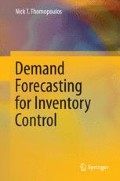Abstract
Forecasts are necessary for each part in every stocking location as they are used in the stocking decisions on when to replenish the stock and how much. The forecasts are typically revised each month as the new monthly demand entry becomes available. The forecasts are based on the history flow of the demands over the past months. The more accurate the demand history , the better the forecasts. The typical inventory system saves anywhere from 12 to 36 months of demand history.
Access this chapter
Tax calculation will be finalised at checkout
Purchases are for personal use only
Author information
Authors and Affiliations
Corresponding author
Summary
Summary
The more precise and detailed the demand history on each part in the stocking location, the more flexibility and accurate the forecasts become. In the typical stocking location, the demand history is saved in calendar monthly or weekly buckets. Plants often save their demands in fiscal 445 type monthly buckets. One or more years of demand history is needed to generate the forecasts. Various type of demands are saved, depending on the operation of the stocking location. The various type of demand include the following: regular, emergency, advance stock, regular stock, promotion, other-requirements, new stock, advance demand s and return demands . In some stocking locations, the history of the number of customer lines is saved and becomes useful in generating the forecasts. Sometimes outlier demands creep into the demand history and it is important to seek out and adjust the outliers accordingly. The more accurate demands, the better the forecasts. Care in the forecasts is essential, since good forecasts will minimize the events of lost sales, backorders and surplus. The coefficient of variation , cov, is a useful relative measure on the forecast accuracy of a part. Also described is the cumulative round algorithm that converts fractional forecasts into integer forecasts . Also of occasional need are cumulative forecasts for various durations of the future months.
Rights and permissions
Copyright information
© 2015 Springer International Publishing Switzerland
About this chapter
Cite this chapter
Thomopoulos, N. (2015). Demand History. In: Demand Forecasting for Inventory Control. Springer, Cham. https://doi.org/10.1007/978-3-319-11976-2_2
Download citation
DOI: https://doi.org/10.1007/978-3-319-11976-2_2
Published:
Publisher Name: Springer, Cham
Print ISBN: 978-3-319-11975-5
Online ISBN: 978-3-319-11976-2
eBook Packages: Business and EconomicsBusiness and Management (R0)

